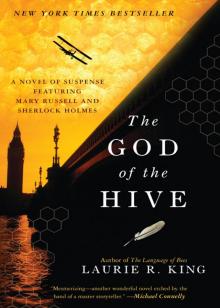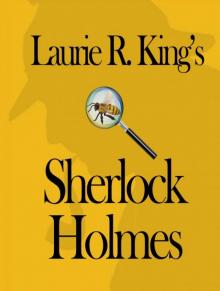- Home
- Laurie R. King
Night Work km-4 Page 2
Night Work km-4 Read online
Page 2
“Funny place to have a heart attack,” Kate remarked. “And he wasn’t exactly dressed for jogging.” What they could see of the body, half hidden by the bushes at the side of the paving, was clothed in heavy, stained work boots and some sort of khaki pants. “And why on earth didn’t anyone spot it during the day? This is a pretty heavily used road.”
“Not as many people on foot as usual, because of the rain. It was getting dark, so the guy who found him figured it was safe to stop and have a pee, happened to stop here.”
There was a certain humor in the picture, which Kate turned over in her mind as they waited to be allowed access to the body. Al broke into her thoughts with a question.
“Why do you suppose he was dropped here? Other than it’s dark and you can see cars coming?”
Kate looked around, and she had to admit that it was not the first place she would have chosen for easy disposal of an inconvenient corpse. “If it’d been me, I’d have gone on down there,” she told her partner, nodding toward a cluster of dark buildings in the hollow of the hill. “There’s no gate across the access road, is there?”
“Nope. And the park guys say there wasn’t anything going on there last night, shouldn’t have been any traffic down there at all.”
Kate turned and looked in the other direction, up the hill. On the other side of the road, some brambles and trees rose up, then the fence that surrounded the cemetery. “You suppose they were aiming for the cemetery but missed? Maybe there were people in there, scared the perps off.” She herself had run through the Presidio when she was feeling ambitious, and knew the cemetery for a closed-in area with limited access and regular visitors; too likely to get trapped in there, and hard to explain a dead body missing its casket and mortuary van.
Eventually, the ME stood away and she and Hawkin moved into the glare of the portable floodlights to get a closer look at their dead white male.
Dead he clearly was, and Kate agreed that trying CPR on that darkened face with that swollen, froth-covered tongue protruding was not a cheering prospect.
“Strangled,” she said, pointing out the obvious.
“With something other than hands,” Al added as he lifted back the collar of the man’s plaid shirt. Something had torn into the soft skin of the throat, chafing it raw as it did its work.
The man had blunt features, cropped hair, and the coarse bloom of long-term alcohol use in his nose. His belly was big and soft although his chest and upper arms appeared muscular where his shirt had been pulled away by the paramedics. He wore a jeans jacket but cotton-polyester uniform trousers, and a belt with a buckle declaring the man’s loyalty to Coors beer.
“Are his hands tied?”
Al tugged at the inert shoulder, which showed signs that rigor mortis was passing off, to reveal the man’s thick wrists. They wore a pair of regulation police handcuffs identical to those in Kate’s bag. Neither of them commented on the cuffs, but Al held the man’s torso off the ground until Kate had removed a fat wallet from the hip pocket of the pants, then eased the body back down until it was lying as it had been when Kate arrived on the scene.
“Not robbery.” It was Al’s turn to point out the obvious. A gold band dug deep into the flesh of the man’s meaty ring finger, and in his wallet were eighty-two dollars, a stack of membership cards to video rental parlors, a credit card, and a California driver’s license that identified the corpse as one James Larsen, with an address in the bedroom community of South San Francisco. A working man’s address to match his clothes and his hands, and somewhat out of the ordinary for a San Francisco homicide victim.
They patted down James Larsen’s pockets with care, since the rubber gloves both detectives wore gave no protection against the myriad of sharp and potentially lethal objects people carried around. Kate found a ticket stub to an action movie dated three days before, six coins, a used handkerchief, and the wrapper from a stick of beef jerky. No keys. Al slid a hand into Larsen’s left-side jacket pocket and pulled out three cellophane-wrapped pieces of candy: a lump of hard butterscotch, a flattened square of striped coconut chew, and a squashed wad of something red and soft. Mr. James Larsen, it would appear, had had a sweet tooth.
Hawkin dropped the candies into an evidence bag and stood up to let the rest of the team move in. The photographer took a few close-ups to go with his earlier shots of the crime scene as it had appeared before anyone went near the body, and the Crime Scene officers bent to their labors. Kate and Hawkin walked over to where the techs were leaning against their van, the smoke from their cigarettes mingling with the tang of eucalyptus in the cool night air. All four city employees ignored the calls of the gathered news media as if it had been the noise of so many plaintive seagulls.
“Any idea when the autopsy’ll be?” Al asked them.
“Might be tomorrow, more likely the next day. The morgue’s pretty crowded.”
“Let me know.”
“But I can tell you now what they’ll find,” the man continued.
“Clogged arteries, a bad liver, and strangulation,” Hawkin offered.
“A taser.”
“What?”
“A stun gun, taser, whatever you call it. One of those things women carry. It wouldn’t have killed him, but whoever did this used one to put him down.” The tech threw his cigarette on the pavement and ground it under his heel, blithely contaminating the periphery of a crime scene, then led the two detectives over to the body. He squatted and pulled the plaid shirt back again from Larsen’s strong chest. “That’s a taser burn,” he asserted, pointing to a small red area, and looked up to catch their reaction.
There was none. Both detectives kept their faces empty, and Al merely said, “I suggest you keep that theory to yourself,” casting a quick glance over his shoulder at the waiting reporters, and allowed the process of removing the body to go on.
Still, Kate made a note of what the tech had said before she followed Al over to where they had parked their cars.
“It looked more like a bruise to me,” she said firmly, as if saying so would make a bit of difference. Her partner grunted. “And really, even if it is a taser—”
“We’ll know soon enough,” Al remarked, and walked over to give the reporters what little he could. Or would.
The taser, if the mark on James Larsen’s chest was not bruise, birthmark, pimple, or the growth of some exotic contagion, would create a problem, because that was how the Ladies of Perpetual Disgruntlement, that source of sly jokes at school parties and embarrassment to mayors and cops, began life: with a taser.
The reign of the Ladies (quickly shortened by an admiring public to the LOPD, although they referred to themselves as merely the Ladies) had begun back in late January, when a lowlife named Barry Doyle was acquitted of statutory rape. Belinda Matheson, aged fifteen years and ten months, had gone cruising with some friends with a borrowed ID that looked very like her (hardly unusual, since it belonged to her older sister) and declared her to be twenty-one. Doyle was twice her age, although his boyish features had a vague resemblance to Leonardo DiCaprio, and the combination of his cute face, his clever flattery, and his illicit booze had landed the teenager in Doyle’s bed. Her parents, apoplectic with worry by the time Belinda dragged herself home the next afternoon, furiously pressed charges, but Doyle had a good lawyer and drew an inexperienced prosecutor who allowed a jury that was predominantly male and exclusively unmarried or divorced. The combination of testimony—that Doyle had been seen to check Belinda’s ID, reassuring himself that she was no minor; that she had looked to be the person on the license (this bolstered by a blowup photo of Belinda in adult makeup and upswept hair); and most damaging of all, that she was by no means an innocent (this last from an ex-boyfriend who showed great promise for stepping into Barry Doyle’s sleaze-covered shoes)—conspired to produce a verdict that had Doyle, owner of six adult video parlors and a topless bar that the jury knew nothing about, crowing his victory over the forces of “disgruntled feminists and other h
uman rights fascists” right there on the courthouse steps—and announcing that he was in turn suing the Matheson family for the “emotional, financial, and professional damage” he had suffered through their “cold-blooded deception.” He ended his impromptu press conference by looking straight into the nearest television camera and declaring, “Fair’s fair, Belinda.”
Shortly before midnight that same day, following a wild celebratory dinner, Doyle vanished somewhere between his car and his front door. He was discovered eight hours later by morning commuters, quite alive if spitting with rage, stark naked and spread-eagled across the window of a building under renovation. His genitals had been dyed purple (as could be seen from the cars that were soon at a complete halt on the freeway) and the duct tape that suspended him from the window frame ripped most of the hair off his wrists, ankles, and face, but most shocking (and delicious) of all was the revelation that underneath the purple dye, he had been tattooed. The phrase I SCREW CHILDREN was now an indelible part of Barry Doyle’s equipment, until such time as he was driven to submit to the pain of eradication, and the note duct-taped to his backside put the cap on the episode: fair’s fair, dick.
—The Ladies of Perpetual Disgruntlement
Oh joy, oh ecstasy, on the part of all the world that had never flirted with the idea of bedding an underage girl. And oh the discomfort, oh the uneasy shriveling felt by all society’s members (so to speak) who had. A thousand duct-tape jokes bloomed on late-night television, the color purple took on a whole new significance, tattoo artists became the heroes (and the suspects) of the hour. The Ladies instantly overtook their predecessors in the Only-in-San Francisco category, the gay/lesbian/bi/ and-a-few-straights protest group called the Sisters of Perpetual Indulgence. In three days the Ladies had half a dozen fan Web sites, twenty designs of T-shirts for sale around the city’s tourist sites (all of them purple), and a hundred jokes about how many Ladies it took to tattoo a man. (A representative answer: None at all, if he’s a true Dick.) Even Doyle’s friends began to forget that his name was Barry.
Since then, the Ladies had struck twice more. Their most visible action was when a billboard went up, again overlooking the freeway and this time only five hundred yards from police headquarters, showing the face of a prominent local politician superimposed on a male with a naked child in his lap (the politician took an immediate extended vacation, considered by all a sure admission of guilt). Taped to the billboard’s access ladder was a note saying:
NAUGHTYBOY.
—the Ladies
Their third strike was against a chronic flasher out in the Sunset, overcome by a taser-wielding duo and duct-taped, naked and face-forward, to embrace a metal lamppost on a very cold night. The note taped to his anatomy read:
BITDRAFTY?
—the Ladies
The official Departmental line, of course, was that vigilante actions of this sort were wrong, dangerous, and not to be tolerated. But there were as many cracks about frostbite within the walls of the Justice building as there were outside, and a cop only had to murmur the words “duct tape” to have the room convulsed.
Other actions had been attributed to the Ladies of Perpetual Disgruntlement, both in the Bay Area and across the state, but none were certain, since they lacked the hallmark humor. The police had no more idea who the Ladies were (or even if they were actually women) than they had in January. The obvious suggestion, that some of the “nuns” of the Sisters of Perpetual Indulgence had decided to grow teeth, was investigated, but no links were found beyond the middle words in the two names and their clear common regard for irreverence. No fingerprints had been found on the duct tape, no identifiable evidence recovered from the crime scenes, the three notes were on paper sold by the ream in chain stores and generated by software and a computer and printer that half of the state could own. Even the billboard, as public an act as could be imagined, had been a fast strike involving prepainted sheets and wallpaper glue. All the police knew was that the Ladies struck at night, and that two of their actions had involved tasers.
And now a man with a possible taser burn on his chest lay dead.
Crime Scene agreed that, particularly as the rain seemed to have stopped for the night, it would be far better to leave the site until morning. Al arranged for the road to remain closed off and for the scene to be guarded from the depredations of the cameras, before the two detectives went to interview their only witness.
The jogger who had come across the body seemed to be just that, not the murderer returned to the scene to “discover” his victim. He even produced the stub from an airline boarding pass to prove that he had only returned that morning from a business trip. They thanked him and left, and then set off to the Larsen home, to make the announcement and see what they could see.
THE LARSEN ADDRESS WAS in South San Francisco, half an hour down the peninsula from the city and a different world. The big white letters on the hillside declared South San Francisco to be THE INdustrial CITY, a place dominated by San Francisco International and all the freight, crated and human, that the airport moved.
The Larsen house proved to be one of a thousand cramped stucco boxes thrown up after the war. Even in the inadequate illumination from their flashlights and one dim street lamp, the house showed every year of its half century. Weeds grew in the cracks of the walkway, the cover of the porch light had broken and been removed, and the paint was dull and beginning to peel. Al put his thumb on the bell, and after a minute of no response pounded on the door, but the house remained dark. A trip around the building with flashlights at the windows showed them merely the untidy interior of a tract house, so they split up, heading in opposite directions along the street to stop in at every house where lights still showed. When they met up again to compare notes, the information each had gleaned from the neighbors amounted to the same thing.
The Larsen family had lived here for at least ten years. James worked as a baggage handler at the airport, his wife, Emily, kept house. Their two kids were grown and moved away. His wife had recently left him, and the across-the-street neighbor he went bowling with, the only one who might possibly know where Larsen’s wife or kids were, was away on vacation, due back in three or four days. The one piece of information Kate could add concerned the Larsen car, a six-year-old Chevrolet sedan. DMV gave her the license number, and as they sat in the front seat of Kate’s car to write up their field notes, she put out a bulletin for the car. Then, since there was not a great deal more they could do at that time of night, and since there seemed to be no immediate reason to roust a judge out of bed to sign a search warrant, they went their separate ways through the dark and drowsing peninsula, and were both in their beds not so much after midnight.
A deceptively ordinary beginning to a far from ordinary case.
Chapter 2
ONE OF THE MEDICAL techs had talked. Either that, or the Chronicle reporter had a contact within SFPD who had heard the rumor, because the front page of the paper that Kate fetched from the flower bed the following morning had the story of the body found in the Presidio, an indistinct picture of Al Hawkin walking away from it, and the clear speculation that the death was linked with the Ladies of Perpetual Disgruntlement. Kate cursed, told Lee that she wouldn’t be having breakfast, and while Hawkin was out checking on the progress of the crime scene search, Kate set off to hunt down the history of a victim.
James Larsen had a lengthy arrest record, though only two convictions: one for drunk-and-disorderly at the age of nineteen, and one five years before his death, for assaulting his wife. In the twenty-five years between those two convictions, Emily Larsen had been a regular visitor to the hospital emergency room, but had consistently refused to press charges. Only in recent years, when the law was changed to make spousal cooperation unnecessary for domestic violence prosecution, had Larsen been vulnerable.
Since then he had been careful. The police still came to his house every six or eight months, but they had not arrested him again until the end of Febr
uary, when the beer binge that he had begun the day before fed into resentments real and imagined and was topped off by his anger over his favorite team’s defeat, leaving Emily bleeding onto the floor of the emergency room. He had been arrested and charged with attempted murder, and bail was placed too high for him to reach. Three weeks later the charges were reduced, to battery and assault, and a tired judge had sentenced him to time served, a year of probation, a hundred hours of community service, and marriage counseling. He then turned Larsen loose. Two weeks after that, a pair of SFPD homicide detectives were standing over his corpse.
Just before his release from jail, according to the neighbors, Emily had packed her bags and been driven off by a woman in a Mercedes; she had not been seen since. Or heard from: Emily’s few acquaintances did not know where she was, her sister in Fresno hadn’t spoken with her since early March, and their father, in a rest home near Fresno, neither knew nor was he interested.
When Emily Larsen had not shown up at her house the following morning, Kate had asked the phone company to preserve the records of the incoming calls for a few days, and then made out a request for a search warrant on the records for the Larsen phone. It was the previous month’s phone bill that gave the missing woman away. Four days before her husband was released from jail, Emily had made a telephone call to a lawyer’s office in San Francisco. Kate, working her way through the calls, heard the greeting “Law offices” and knew she’d found the wife. She identified herself, asked to speak with the partner who was representing one Emily Larsen, declined to be called back, and settled in with her heels on the desk to wait. She listened to the piano music of call-holding coming through the receiver, understanding that legal dignity required that a cop be made to wait. She’d done the same herself to lawyers. With the phone tucked under her chin, she sat tight and glanced through a stack of memos and Daily Incident Recaps that had been accumulating on her desk. The recaps, in addition to the usual list of attempted robberies, hit-and-runs, and sexual assaults, included the laconic description of assault by a chronic urinator who was proving a nuisance to passers-by—particularly those on bicycles. The memos included one decree (what Kate reckoned was the thirtieth such issued) that department personnel were not, under any circumstances, to make jokes about the Ladies of Perpetual Disgruntlement, or duct tape, or the color purple. Another memo was the announcement that an unknown group had been plastering up flyers seeming to advocate the extermination of all male children, which caused Kate to read it more closely and shake her head. She was looking at a third memo bearing a stern reminder concerning the cost to local supermarkets of the oversized plastic shopping carts favored by the homeless, when the music in her ear cut off abruptly and a woman’s voice spoke in her ear.

 O Jerusalem
O Jerusalem Beekeeping for Beginners
Beekeeping for Beginners The God of the Hive
The God of the Hive The Language of Bees
The Language of Bees Night Work
Night Work Justice Hall
Justice Hall The Murder of Mary Russell
The Murder of Mary Russell Lockdown
Lockdown To Play the Fool
To Play the Fool Locked Rooms
Locked Rooms Island of the Mad
Island of the Mad The Art of Detection
The Art of Detection The Mary Russell Series Books 1-4
The Mary Russell Series Books 1-4 The Beekeeper's Apprentice
The Beekeeper's Apprentice For the Sake of the Game
For the Sake of the Game A Darker Place
A Darker Place Mila's Tale
Mila's Tale Mrs Hudson's Case
Mrs Hudson's Case With Child
With Child The Marriage of Mary Russell
The Marriage of Mary Russell The Mary Russell Companion
The Mary Russell Companion Hellbender
Hellbender Castle Shade
Castle Shade The Bones of Paris
The Bones of Paris Riviera Gold
Riviera Gold A Grave Talent
A Grave Talent Pirate King
Pirate King Dreaming Spies
Dreaming Spies Folly
Folly Touchstone
Touchstone The Game
The Game The Mary Russell Series Books 1-4: The Beekeeper's Apprentice; A Monstrous Regiment of Women; A Letter of Mary; The Moor
The Mary Russell Series Books 1-4: The Beekeeper's Apprentice; A Monstrous Regiment of Women; A Letter of Mary; The Moor The Moor mr-4
The Moor mr-4 The Birth of a new moon
The Birth of a new moon With Child km-3
With Child km-3 A Letter of Mary mr-3
A Letter of Mary mr-3 Justice Hall mr-6
Justice Hall mr-6 Pirate King: A novel of suspense featuring Mary Russell and Sherlock Holmes
Pirate King: A novel of suspense featuring Mary Russell and Sherlock Holmes Pirate King: A novel of suspense featuring Mary Russell and Sherlock Holmes mr-11
Pirate King: A novel of suspense featuring Mary Russell and Sherlock Holmes mr-11 Beekeeping for Beginners (Short Story)
Beekeeping for Beginners (Short Story) Laurie R. King's Sherlock Holmes
Laurie R. King's Sherlock Holmes Echoes of Sherlock Holmes
Echoes of Sherlock Holmes A Study in Sherlock
A Study in Sherlock The Game mr-7
The Game mr-7 Garment of Shadows: A Novel of Suspense Featuring Mary Russell and Sherlock Holmes
Garment of Shadows: A Novel of Suspense Featuring Mary Russell and Sherlock Holmes Dreaming Spies: A novel of suspense featuring Mary Russell and Sherlock Holmes
Dreaming Spies: A novel of suspense featuring Mary Russell and Sherlock Holmes Night Work km-4
Night Work km-4 Mary Russell's War
Mary Russell's War To Play the Fool km-2
To Play the Fool km-2 A Monstrous Regiment of Women mr-2
A Monstrous Regiment of Women mr-2 O Jerusalem mr-5
O Jerusalem mr-5 A Grave Talent km-1
A Grave Talent km-1